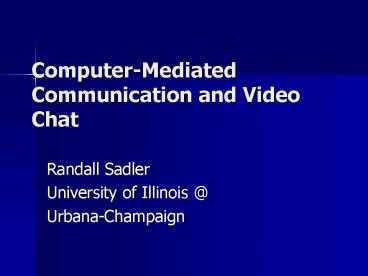Computer-Mediated Communication and Video Chat - PowerPoint PPT Presentation
1 / 19
Title:
Computer-Mediated Communication and Video Chat
Description:
Computer-Mediated Communication and Video Chat Randall Sadler University of Illinois _at_ Urbana-Champaign What is CMC/NBLT? Computer-Mediated Communication (for ... – PowerPoint PPT presentation
Number of Views:246
Avg rating:3.0/5.0
Title: Computer-Mediated Communication and Video Chat
1
Computer-Mediated Communication and Video Chat
- Randall Sadler
- University of Illinois _at_
- Urbana-Champaign
2
What is CMC/NBLT?
- Computer-Mediated Communication (for language
learning) is the use of computers connected by
networks to engage in authentic communication
with other language learners and/or teachers.
NBLT represents a new and different side of
CALL, where human-to-human communication is the
focus (Kern Warschauer, 2000, p. 1).
3
How is that different from CALL?
- CALL has traditionally been associated with
self-contained, programmed applications such as
tutorials, drills, simulations, instructional
games, tests, and so on (Kern Warschauer,
2000, p. 1) .
- Many of these influenced by The Audiolingual
Approach - Aka, Drill and Kill
4
A VERY short review of research
- Email Absalon Marden, 2004 Biesenbach-Lucas
Weasenforth, 2001 Fedderholdt, 2001 O'Dowd,
2003 Shang, 2003 - Message Boards Benton, 1996 Kamhi-Stein, 2000
Ware, 2004 - MUDs and MOOs Kötter, 2001b Peterson, 2001
Weininger Shield, 2003 - Text Chat Bearden, 2003 Freiermuth, 2002
Perez, 2003 D. B. Smith, 2001 Tudini, 2003
Williams, 2003
5
Okay, a fairly short review
- Audio Chat Cziko Park, 2003 Hampel Hauck,
2004 Kötter, 2001a Kötter, Shield, Stevens,
1999 Lamy, 2004 - Video Conferencing Goodfellow et al., 1996
Kinginger, 1998 Matthews, 1998 McAndrew,
Foubister, Mayes, 1996 Egert, 2000 - Video Chat Wang, 2004
6
Research Questions
- What programs are freely available for engaging
in synchronous video chat? - How different are these tools from each other in
terms of technical and pedagogical issues? - How suitable are these programs for personal
communication? - How suitable are these programs for language
teaching purposes?
7
What did the study do?
- Evaluated 8 freely available video chat programs
- CU-See Me World
- ICQ
- MSN Messenger
- Paltalk
- Skype
- Yahoo Messenger
8
Participants
- Turkey
- 8 MATEFL students
- 4 female 4 male
- Taking course on The use of computers for
language learning
- US
- 10 MA TESL students
- 5 male 5 female
- U.S., Argentina, China, Cambodia, and Korea
- Taking course on CMC for Language Teaching
9
Procedure
- Groups of 2-3 students used each program for
international communication - Each student completed a 28-item questionnaire
for each tool a final questionnaire - 3,132 item responses total
10
Results
Tool M (over 95) SD Rank
MSN 80.50 13.10 1
Skype 76.55 9.30 2
Yahoo 56.44 14.23 3
ICQ 46.77 15.20 4
CUworld 41.83 15.16 5
Paltalk 35.61 16.63 6
11
Paired t-tests15 possible combinations of video
tool pairs.
MSN Messenger MSN Messenger Skype
Yahoo ICQ Yahoo ICQ Yahoo ICQ
ICQ CUworld ICQ CUworld ICQ CUworld
CUworld CUworld Paltalk
12
Technical Use Issues
13
The Upper 3rdMSN Skype (Traditional)
14
What they liked/disliked
- High audio and video quality
- Ability to make landline calls
- Familiarity
- No possibility for multi-user video chat
- Skypesmall user video
15
The Lower 3rdPaltalk CUworld (Community
Oriented)
16
What they liked/disliked
- Potential for multi-user chat
- Pre-existing interest groups
- Free usage restricted
- Button turn-taking (Paltalk)
- Technical Issues (CUworld)
- Wow/Yikes Factor
17
The Middle 3rdYahoo ICQ (Transitional Tools)
18
The Middle 3rdYahoo ICQ (Transitional Tools)
- Free
- Multiuser video chat for freeICQ
- Some video and audio issues
- Annoying extra software (Yahoo)
- Chat overload317
19
What does all this mean for us?
- Do you need video?
- In class or out of class usage?
- Individual or class to class (videoconferencing)?
- Free or pay?
- 1-1 or multi-person communication?
- Have a partner or need a partner?
- xLingo mylanguageexchange

